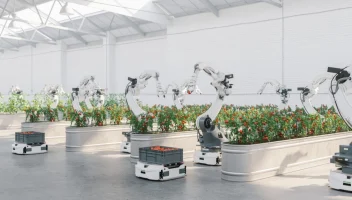Exploring the Future of Food and Beverage with Phil Lempert at Aptean’s Food and Beverage Forum
Exploring the Future of Food and Beverage with Phil Lempert at Aptean’s Food and Beverage Forum
Exploring the Future of Food and Beverage with Phil Lempert at Aptean’s Food and Beverage Forum
26 Mai 2021
Aptean Staff Writer
Aptean’s 2021 Food and Beverage Forum, held virtually on May 25, was headlined by keynote speaker Phil Lempert, the “Supermarket Guru” and industry expert known for his television appearances, reporting, podcasts and marketing knowledge.
Lempert’s presentation explored how consumers have changed over the past several years, especially during the year-plus of the COVID-19 pandemic, as well as the ongoing supply chain challenges and how technology is being used to overcome these issues and change the way we shop.
To explain the causes and effects of current trends, Lempert focused on six high-level topics that illustrate the changing landscape of the food and beverage marketplace. Here we cover these points and the insights offered in his presentation.
1. The Importance of Mindfulness
Consumers today are far more focused on their thoughts and feelings regarding food and beverage as opposed to viewing shopping as merely a simple transaction. They’re driven by their social conscience, a desire to support local businesses, opportunities to “hack” their lives for optimization and better health through enhanced nutrition.
Lempert referenced filmmaker Morgan Spurlock’s new concept, “transparelocalicious,” to succinctly illustrate those matters that are most crucial for customers. They’re increasingly expecting the brands they do business with to be transparent when it comes to their supply chains, locally and responsibly sourced and—somewhat unsurprisingly—delicious.
For example, 77% of consumers say that they read ingredient labels “often,” and 64% follow some sort of exclusion diet based either on principle or health concerns. What’s more, nearly half—47% to be exact—expect personalized experiences when it comes to shopping for food and beverage.
As a result, more retailers are focusing on making their stores more inviting, friendly and inspiring, showcasing brands that have cause-related marketing (CRM) approaches like those of Honest Tea, Vita Coco and Justin’s. This curation of the customer journey is designed to encourage loyalty and demonstrate the store’s commitment to wellness and the local community.
2. The Need for a Tactile Experience
Grocery stores are filled with colorful products that invite the customers to interact, and consumers have embraced this and now expect a multisensory experience at the store. Retailers are using technology like augmented reality (AR) to meet this demand.
At the same time, this more involved and personal shopping journey results in increased fixed costs, as stores must adhere to stricter cleaning standards when more customers are touching, picking up and closely examining products. COVID-19 brought with it a host of additional sanitation measures to keep both customers and employees safe, and with still more being added, retailers need to find a way to recoup some of these expenses.
Many have been focusing on minimizing waste to mitigate their extra cleaning costs. Lempert gave the example of bakery departments that are now taking advantage of 3D printing for the baking of customized cakes. Previously, many generic cakes ready for personalization would be baked and only some would be purchased, with the rest being donated or thrown out, but now, consumers can do the customization themselves either with an in-store interface or at home via the internet, and their cake can be made on-demand, increasing the chances that everything made is eventually sold.
3. Newer, Better Ways to Farm
With the impacts of global warming already being felt—especially in California, which experienced widespread wildfires and drought in 2020 that severely impacted its massive agricultural sector—finding new ways to farm that are more environmentally friendly and resilient to adverse climate events are becoming more popular.
Vertical farming and hydroponics are two of the most exciting and disruptive new methods being explored. These systems—which can be used to grow everything from leafy greens to bananas and potatoes—are renewable and produce 70% less waste. They also offer a controlled environment in which produce can be grown year-round at roughly three times the speed it takes to harvest using traditional methods.
Meanwhile, 73% of consumers prefer companies that are more transparent and sustainable. They want to know where their food came from and what went into it, and that’s driven many retailers to seek out partnerships with local farms. Some farms are also expanding their direct-to-consumer models to replace lost income from the foodservice sector during periods of lockdown.
Of course, some of these efforts to make farming more responsible will result in higher costs. Coca-Cola and Tyson have already stated that prices will likely increase due to their own increased expenses, but consumers have shown a preference for this sort of straightforward, truthful approach to marketing as opposed to less transparency, even if that would result in cheaper products.
4. Neuronutrition and Biohacking
With food now the leading cause of preventable death, food and beverage brands and consumers alike are seeking healthier, safer products. Top concerns include heart, bone, gut and brain health, with the importance of the last being seen in the rise of marketing related to EPA and DHA omega-3 fatty acids and their benefits.
New more scientific approaches to food are being championed, as evidenced by the growth of cellular agriculture, as well as the trend to hire staff nutritionists and dieticians at restaurants and grocery stores alike. Additionally, new DNA tests that can provide personalized nutrition advice are gaining in popularity, with GenoPalate being among the leading providers of such services.
As these new developments emerge, some issues surrounding them will need to be addressed. The DNA testing services, for instance, tend to overload customers with information and recommendations for foods to eat and foods to avoid, so some simplification is in order before they gain widespread acceptance and adoption.
5. The Concept of “Technofoodology”
From artificial intelligence to the Internet of Things and other smart devices, all matter of technology is now being applied in the food and beverage sector. At the store level, that means communicating with shoppers via their phones and watches, as well as implementing AR displays and even smart gloves for easier interface navigation.
As far as consumers’ homes, Lempert pointed out that more than 120 million U.S. households now have broadband connections and 60% have smart devices. They use those devices to search for recipes and look up nutritional info, and at the same time their smart fridges and cupboards are monitoring the levels of the products they contain and prompting reordering when amounts run low.
This constant connection between brands, their products and their customers reduces friction in the shopping experience, which is ideal for all parties involved. It’s also leading to less waste, as automated notifications keep consumers apprised of just how much they have left of certain products, informing smart purchasing at the store.
6. Future of Supermarkets
Lempert pointed out the success of Aldi in capturing millennial and Generation Z shoppers on the strength of the retailer’s efficiency, quality and low costs. Their stores—which have smaller footprints—aren’t designed like the big box locations of yesteryear that focused on housing as many different products as possible.
Of course, the rise of Instacart and other third-party shopping services has been a major disruptor and only picked up steam during the months of social distancing and limited store capacities. Many consumers still want to pick their own produce, meat and seafood, though, as not all personal shoppers are trained in selecting the best products in these areas, and the inconvenience of vague delivery windows has been a major frustration for users.
Retailers like Albertson’s, meanwhile, are trying to reclaim the shopping experience by restricting the use of customer loyalty cards and coupons to only those customers who shop in store or via their own online portal, which itself accounts for about 20% of their sales. A focus on fostering a relationship with consumers and creating “wow” moments is being embraced by other brands, too.
According to Lempert, the supermarket of the future will continue to integrate new technologies and may even switch to a model of a fully robotic mini-fulfillment center backend. At the same time, a front end that focuses on interactive experiences with local providers can create the sort of fun, inviting atmosphere that many of today’s traditional stores lack.
Forging Forward
Key trends to watch are “click and collect” online shopping models, the continued rise of veganism and other plant-based innovations in food and beverage. Connections with local greenhouses and farmers will also demonstrate the commitment to community health that mindful consumers are looking for.
Technology will continue to push the industry forward and allow food and beverage businesses to clear the hurdles they face as a “new normal” sets in post-pandemic. If your business wants to be at the forefront of this digital transformation, reach out to us today to hear about our industry-specific solutions for food and beverage businesses like yours.
Related Content





A Thorough Adoption Process is Crucial for a Successful ERP Implementation
9 important steps for an optimal return on investment from your new ERP solution



